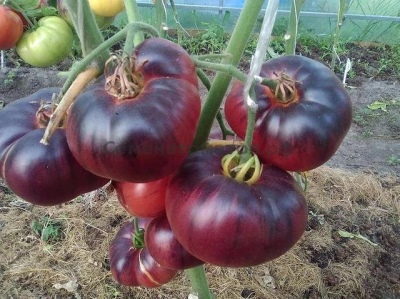
- Authors: Brad Gates, Wild Board Farm, California, USA
- Appeared when crossing: Beauty King x Black Tomato
- Name synonyms: Blue Beauty, Blue Beauty
- Category: grade
- Growth type: indeterminate
- Appointment: universal
- Ripening period: mid-season
- Ripening time, days: 120
- Growing conditions: for open ground, for film greenhouses, decorative landscaping
- Marketability: Yes
This culture is one of the fruits of American selection. But even in domestic conditions, it can prove itself relatively well. The main condition for success is a careful study of all the subtleties.
Description of the variety
This plant has an official synonym - Blue Beauty. The designation "Blue Beauty" is also found. The tomato, created by the efforts of Brad Gates (California), demonstrates an indeterminate developmental dynamics and is capable of becoming a versatile plant.
It is noteworthy that along with the traditional cultivation in the open field and in greenhouses under a film, this variety is also suitable for decorative landscaping. Medium-sized bushes rise up to 1.5-1.8 m, differ in a large thickness of the stem and a simple type of leaves.
The main qualities of the fruit
The ripe berries of the Blue Beauty have a non-standard black-raspberry color, and their weight ranges from 0.12 to 0.15 kg. Other features are as follows:
- the shape of a flat circle is typical;
- ribs are present, but they are rather weakly expressed;
- 5 or 6 fruits are formed in one cluster;
- the crop will develop on simple inflorescences;
- keeping quality under normal conditions no more than 5 days, in a favorable environment - up to 45 days.
Taste characteristics
Basically, the natural tomato flavor is immediately noted. It is mixed with an expressive fruity note. The oily pulp is firm and juicy. The peel of the fruit does not have any unpleasant toughness. The meatiness will also delight consumers.
Ripening and fruiting
The variety belongs to the mid-season category. Usually, the ripeness of the crop is reached 120 days after the formation of young shoots. It is stated that the culture is not afraid of weather changes. However, they are still able, of course, to negatively affect the timing of cultivation.
Yield
1 bush can grow 3-3.5 kg of berries. The collection on 1 "square" of the garden reaches 7 kg. But these figures are realizable only in good weather conditions. Much depends, of course, on agrotechnical measures.
The timing of planting seedlings and planting in the ground
It is necessary to sow seeds in containers 55-60 days before transshipment into open ground. Specific dates are determined taking into account regional conditions, actual and expected weather. It must be clearly understood that for tomatoes, the soil temperature is no less, and partly more significant than the air temperature. Usually they start working with seedlings in the first half of March.

Growing tomato seedlings is an extremely important process, because it largely depends on whether the gardener will be able to harvest at all. All aspects must be taken into account, from seedbed preparation to planting in the ground.
Landing scheme
It is recommended to have up to 4 bushes per 1 sq. m. With such a density, an optimal ratio of the number of fruits and ease of care is achieved. Too dense planting, contrary to the apparent evidence, is deliberately ineffective.

Growing and care
Removing redundant stepchildren is a must for success. Plants will also have to be tied to strong supports. It is also worth considering that without proper formation, the Blue Beauty is also unlikely to please with good results. The likelihood of fruit cracking is small - but it's better to play it safe and take action. The formation of the bushes is carried out in 1-3 stems, and the decision is made by the gardeners themselves.
In order for the seedlings to develop fully, it is necessary to irrigate them through a sieve or using a spray bottle. Lighting with phytolamps is also recommended. Every 14 days, it is advisable to add the "Krepysh" preparation. The pick is made in the phase of 3 true leaves; for this, tanks with a volume of 0.3 liters are used.
Problems arise if the Blue Beauty bushes are exposed to direct sunlight, especially on hot days. Plants are highly recommended to be shaded.
Resistance to pathologies and main pests in this variety is quite high. However, it is fully ensured only with good care and standard agronomic measures. During periods of particularly active damage, it will be necessary to carry out protective treatments.




A plant needs different micronutrients at each stage of growth. All fertilizers can be divided into two groups: mineral and organic. Folk remedies are often used: iodine, yeast, bird droppings, eggshells.
It is important to observe the rate and period of feeding. This also applies to folk remedies and organic fertilizers.



























































































